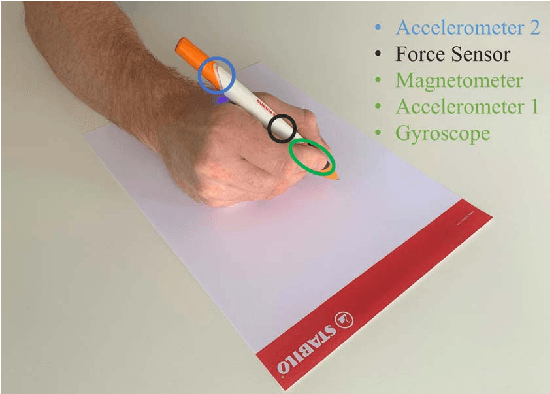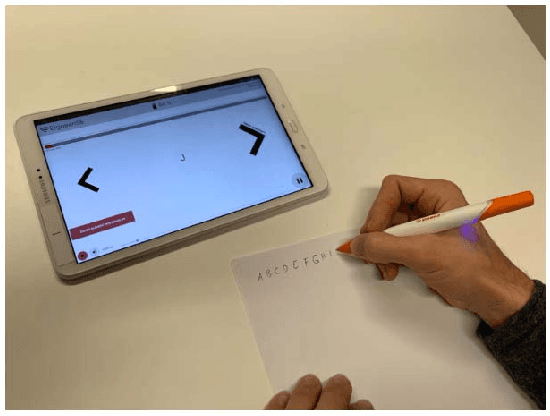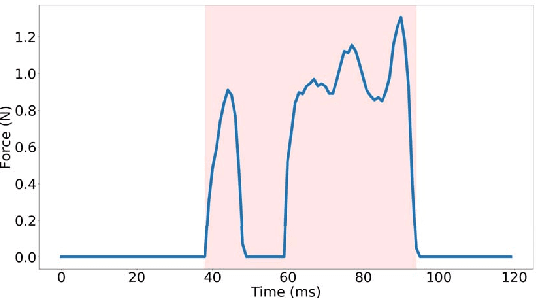Mohamad Wehbi
SVC-onGoing: Signature Verification Competition
Aug 13, 2021



Abstract:This article presents SVC-onGoing, an on-going competition for on-line signature verification where researchers can easily benchmark their systems against the state of the art in an open common platform using large-scale public databases, such as DeepSignDB and SVC2021_EvalDB, and standard experimental protocols. SVC-onGoing is based on the ICDAR 2021 Competition on On-Line Signature Verification (SVC 2021), which has been extended to allow participants anytime. The goal of SVC-onGoing is to evaluate the limits of on-line signature verification systems on popular scenarios (office/mobile) and writing inputs (stylus/finger) through large-scale public databases. Three different tasks are considered in the competition, simulating realistic scenarios as both random and skilled forgeries are simultaneously considered on each task. The results obtained in SVC-onGoing prove the high potential of deep learning methods in comparison with traditional methods. In particular, the best signature verification system has obtained Equal Error Rate (EER) values of 3.33% (Task 1), 7.41% (Task 2), and 6.04% (Task 3). Future studies in the field should be oriented to improve the performance of signature verification systems on the challenging mobile scenarios of SVC-onGoing in which several mobile devices and the finger are used during the signature acquisition.
Digitizing Handwriting with a Sensor Pen: A Writer-Independent Recognizer
Jul 08, 2021



Abstract:Online handwriting recognition has been studied for a long time with only few practicable results when writing on normal paper. Previous approaches using sensor-based devices encountered problems that limited the usage of the developed systems in real-world applications. This paper presents a writer-independent system that recognizes characters written on plain paper with the use of a sensor-equipped pen. This system is applicable in real-world applications and requires no user-specific training for recognition. The pen provides linear acceleration, angular velocity, magnetic field, and force applied by the user, and acts as a digitizer that transforms the analogue signals of the sensors into timeseries data while writing on regular paper. The dataset we collected with this pen consists of Latin lower-case and upper-case alphabets. We present the results of a convolutional neural network model for letter classification and show that this approach is practical and achieves promising results for writer-independent character recognition. This work aims at providing a realtime handwriting recognition system to be used for writing on normal paper.
ICDAR 2021 Competition on On-Line Signature Verification
Jun 01, 2021

Abstract:This paper describes the experimental framework and results of the ICDAR 2021 Competition on On-Line Signature Verification (SVC 2021). The goal of SVC 2021 is to evaluate the limits of on-line signature verification systems on popular scenarios (office/mobile) and writing inputs (stylus/finger) through large-scale public databases. Three different tasks are considered in the competition, simulating realistic scenarios as both random and skilled forgeries are simultaneously considered on each task. The results obtained in SVC 2021 prove the high potential of deep learning methods. In particular, the best on-line signature verification system of SVC 2021 obtained Equal Error Rate (EER) values of 3.33% (Task 1), 7.41% (Task 2), and 6.04% (Task 3). SVC 2021 will be established as an on-going competition, where researchers can easily benchmark their systems against the state of the art in an open common platform using large-scale public databases such as DeepSignDB and SVC2021_EvalDB, and standard experimental protocols.
Towards an IMU-based Pen Online Handwriting Recognizer
May 26, 2021



Abstract:Most online handwriting recognition systems require the use of specific writing surfaces to extract positional data. In this paper we present a online handwriting recognition system for word recognition which is based on inertial measurement units (IMUs) for digitizing text written on paper. This is obtained by means of a sensor-equipped pen that provides acceleration, angular velocity, and magnetic forces streamed via Bluetooth. Our model combines convolutional and bidirectional LSTM networks, and is trained with the Connectionist Temporal Classification loss that allows the interpretation of raw sensor data into words without the need of sequence segmentation. We use a dataset of words collected using multiple sensor-enhanced pens and evaluate our model on distinct test sets of seen and unseen words achieving a character error rate of 17.97% and 17.08%, respectively, without the use of a dictionary or language model
 Add to Chrome
Add to Chrome Add to Firefox
Add to Firefox Add to Edge
Add to Edge